Speech Pathology Assistant: Unit 1 Short Answer Questions Help
VerifiedAdded on 2023/06/11
|13
|3441
|144
Homework Assignment
AI Summary
This assignment provides detailed answers to short answer questions related to speech pathology. It covers key areas such as understanding client impairments and communication needs, the scope of practice for support practitioners, ensuring program continuity, the role of interpreters, essential equipment, obtaining client consent, confirming therapeutic outcomes, and familiarizing oneself with therapy methods. Additionally, it addresses client motivation, simulation techniques, providing sufficient practice opportunities, risk management principles, delivering prompt feedback, identifying communication goals, seeking advice when goals aren't met, developing supportive activities, and seeking assistance when issues arise outside one's scope. This resource helps in understanding the multifaceted aspects of supporting speech and communication skills in clients.

Running head: SPEECH PATHOLOGY
Speech pathology
Name of the student:
Name of the University:
Author’s note
Speech pathology
Name of the student:
Name of the University:
Author’s note
Paraphrase This Document
Need a fresh take? Get an instant paraphrase of this document with our AI Paraphraser
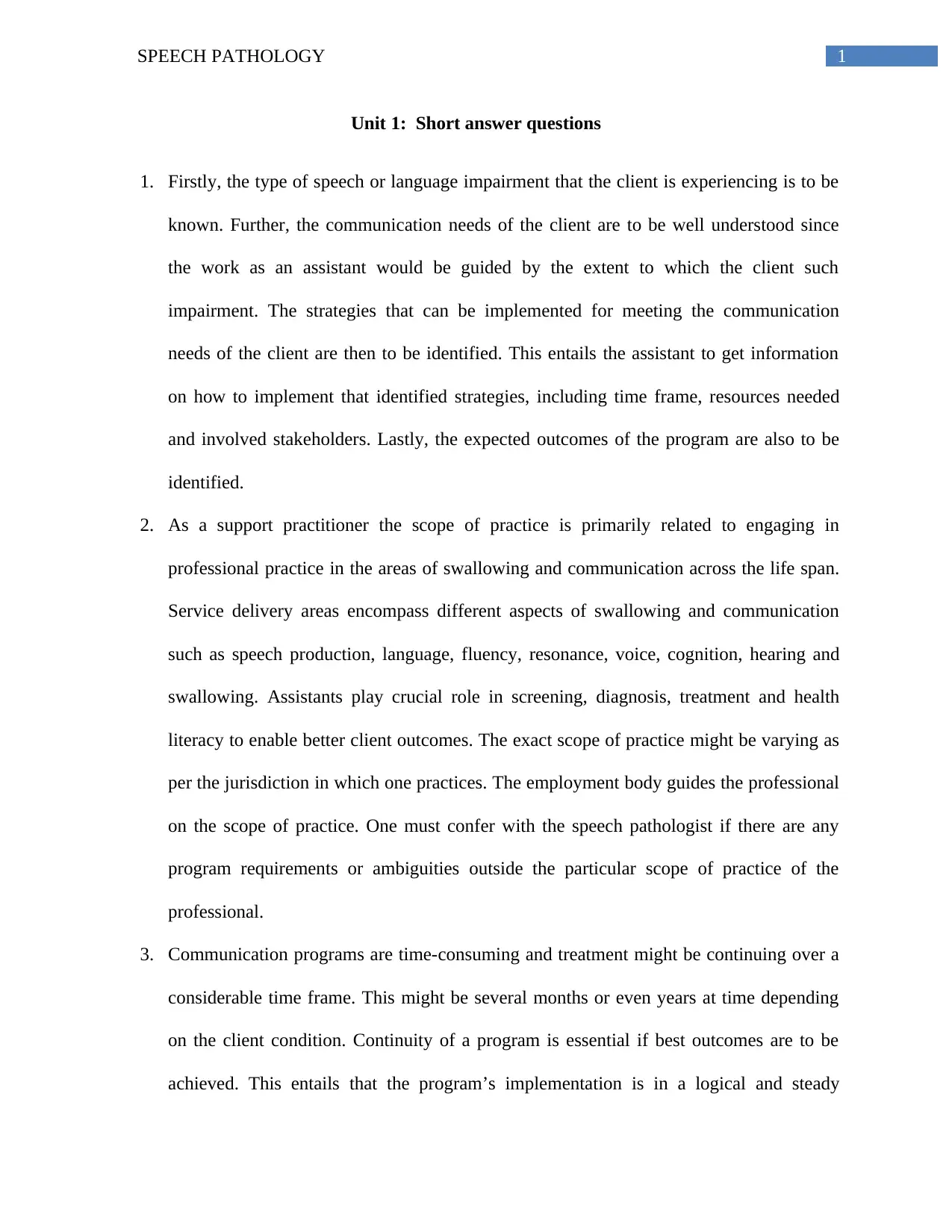
1SPEECH PATHOLOGY
Unit 1: Short answer questions
1. Firstly, the type of speech or language impairment that the client is experiencing is to be
known. Further, the communication needs of the client are to be well understood since
the work as an assistant would be guided by the extent to which the client such
impairment. The strategies that can be implemented for meeting the communication
needs of the client are then to be identified. This entails the assistant to get information
on how to implement that identified strategies, including time frame, resources needed
and involved stakeholders. Lastly, the expected outcomes of the program are also to be
identified.
2. As a support practitioner the scope of practice is primarily related to engaging in
professional practice in the areas of swallowing and communication across the life span.
Service delivery areas encompass different aspects of swallowing and communication
such as speech production, language, fluency, resonance, voice, cognition, hearing and
swallowing. Assistants play crucial role in screening, diagnosis, treatment and health
literacy to enable better client outcomes. The exact scope of practice might be varying as
per the jurisdiction in which one practices. The employment body guides the professional
on the scope of practice. One must confer with the speech pathologist if there are any
program requirements or ambiguities outside the particular scope of practice of the
professional.
3. Communication programs are time-consuming and treatment might be continuing over a
considerable time frame. This might be several months or even years at time depending
on the client condition. Continuity of a program is essential if best outcomes are to be
achieved. This entails that the program’s implementation is in a logical and steady
Unit 1: Short answer questions
1. Firstly, the type of speech or language impairment that the client is experiencing is to be
known. Further, the communication needs of the client are to be well understood since
the work as an assistant would be guided by the extent to which the client such
impairment. The strategies that can be implemented for meeting the communication
needs of the client are then to be identified. This entails the assistant to get information
on how to implement that identified strategies, including time frame, resources needed
and involved stakeholders. Lastly, the expected outcomes of the program are also to be
identified.
2. As a support practitioner the scope of practice is primarily related to engaging in
professional practice in the areas of swallowing and communication across the life span.
Service delivery areas encompass different aspects of swallowing and communication
such as speech production, language, fluency, resonance, voice, cognition, hearing and
swallowing. Assistants play crucial role in screening, diagnosis, treatment and health
literacy to enable better client outcomes. The exact scope of practice might be varying as
per the jurisdiction in which one practices. The employment body guides the professional
on the scope of practice. One must confer with the speech pathologist if there are any
program requirements or ambiguities outside the particular scope of practice of the
professional.
3. Communication programs are time-consuming and treatment might be continuing over a
considerable time frame. This might be several months or even years at time depending
on the client condition. Continuity of a program is essential if best outcomes are to be
achieved. This entails that the program’s implementation is in a logical and steady

2SPEECH PATHOLOGY
manner. It is vital that the speech pathologist and assistant, and the client are engaged in
the program and show commitment over the whole time frame. This is the reason why
one must be determining the availability of the client to take part in the program. If the
program is designed as per the availability of the client the chances of its success is more.
4. An interpreter is required when either the client or the health personnel is facing
challenges in communicating messages to the personnel or the client. Further, an
interpreter might be needed when initial evaluations of the client are carried out since the
information is vital for therapy prescription. In addition, an interpreter is helpful when
client is supposed to engage in decision making regarding care to be delivered. Lastly,
situations when client is supposed to provide legal consent might also need the
involvement of an interpreter.
5. A wide range of equipment would be needed for delivering a speech pathology program.
Some examples are a personalized communication book that has different range of object
symbols; an alphabet board for making out spellings; an assisted and augmented (AAC)
communication device; other speech pathology equipment like to that assist with
positioning of tongue at the time of speech. Different equipment might be necessary for
using the communication systems such as power source, mounting system and software.
All of the mentioned equipment is essential for making the program targeted at the
specific needs of the client.
6. Consent is the specific term used for describing the permission given by the client to
receive a certain procedure or treatment. Before starting with the program it is essential to
inform the client about the need of the consent and obtain the same. In cases where the
client is not able to provide the consent, a third party is to provide the consent. When the
manner. It is vital that the speech pathologist and assistant, and the client are engaged in
the program and show commitment over the whole time frame. This is the reason why
one must be determining the availability of the client to take part in the program. If the
program is designed as per the availability of the client the chances of its success is more.
4. An interpreter is required when either the client or the health personnel is facing
challenges in communicating messages to the personnel or the client. Further, an
interpreter might be needed when initial evaluations of the client are carried out since the
information is vital for therapy prescription. In addition, an interpreter is helpful when
client is supposed to engage in decision making regarding care to be delivered. Lastly,
situations when client is supposed to provide legal consent might also need the
involvement of an interpreter.
5. A wide range of equipment would be needed for delivering a speech pathology program.
Some examples are a personalized communication book that has different range of object
symbols; an alphabet board for making out spellings; an assisted and augmented (AAC)
communication device; other speech pathology equipment like to that assist with
positioning of tongue at the time of speech. Different equipment might be necessary for
using the communication systems such as power source, mounting system and software.
All of the mentioned equipment is essential for making the program targeted at the
specific needs of the client.
6. Consent is the specific term used for describing the permission given by the client to
receive a certain procedure or treatment. Before starting with the program it is essential to
inform the client about the need of the consent and obtain the same. In cases where the
client is not able to provide the consent, a third party is to provide the consent. When the
⊘ This is a preview!⊘
Do you want full access?
Subscribe today to unlock all pages.

Trusted by 1+ million students worldwide
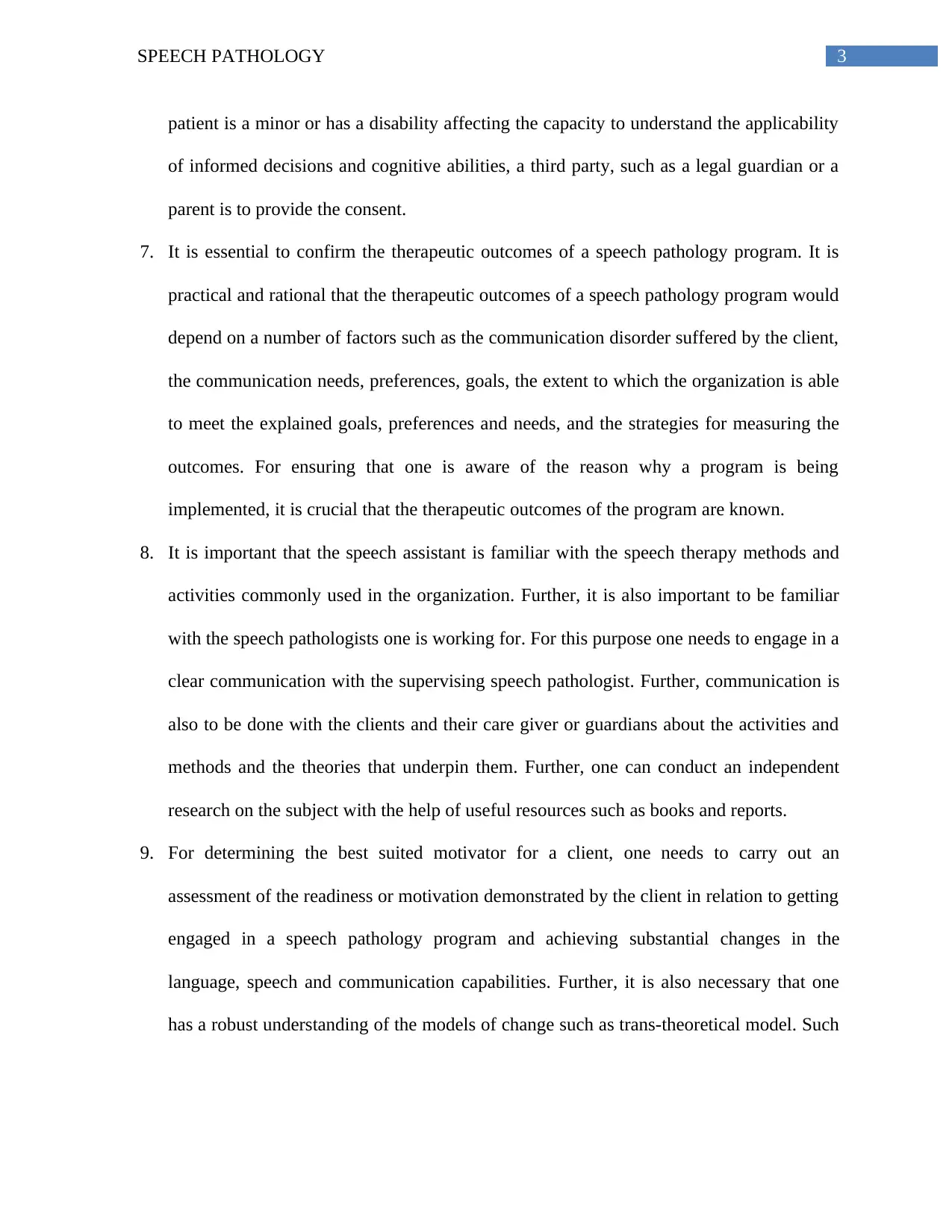
3SPEECH PATHOLOGY
patient is a minor or has a disability affecting the capacity to understand the applicability
of informed decisions and cognitive abilities, a third party, such as a legal guardian or a
parent is to provide the consent.
7. It is essential to confirm the therapeutic outcomes of a speech pathology program. It is
practical and rational that the therapeutic outcomes of a speech pathology program would
depend on a number of factors such as the communication disorder suffered by the client,
the communication needs, preferences, goals, the extent to which the organization is able
to meet the explained goals, preferences and needs, and the strategies for measuring the
outcomes. For ensuring that one is aware of the reason why a program is being
implemented, it is crucial that the therapeutic outcomes of the program are known.
8. It is important that the speech assistant is familiar with the speech therapy methods and
activities commonly used in the organization. Further, it is also important to be familiar
with the speech pathologists one is working for. For this purpose one needs to engage in a
clear communication with the supervising speech pathologist. Further, communication is
also to be done with the clients and their care giver or guardians about the activities and
methods and the theories that underpin them. Further, one can conduct an independent
research on the subject with the help of useful resources such as books and reports.
9. For determining the best suited motivator for a client, one needs to carry out an
assessment of the readiness or motivation demonstrated by the client in relation to getting
engaged in a speech pathology program and achieving substantial changes in the
language, speech and communication capabilities. Further, it is also necessary that one
has a robust understanding of the models of change such as trans-theoretical model. Such
patient is a minor or has a disability affecting the capacity to understand the applicability
of informed decisions and cognitive abilities, a third party, such as a legal guardian or a
parent is to provide the consent.
7. It is essential to confirm the therapeutic outcomes of a speech pathology program. It is
practical and rational that the therapeutic outcomes of a speech pathology program would
depend on a number of factors such as the communication disorder suffered by the client,
the communication needs, preferences, goals, the extent to which the organization is able
to meet the explained goals, preferences and needs, and the strategies for measuring the
outcomes. For ensuring that one is aware of the reason why a program is being
implemented, it is crucial that the therapeutic outcomes of the program are known.
8. It is important that the speech assistant is familiar with the speech therapy methods and
activities commonly used in the organization. Further, it is also important to be familiar
with the speech pathologists one is working for. For this purpose one needs to engage in a
clear communication with the supervising speech pathologist. Further, communication is
also to be done with the clients and their care giver or guardians about the activities and
methods and the theories that underpin them. Further, one can conduct an independent
research on the subject with the help of useful resources such as books and reports.
9. For determining the best suited motivator for a client, one needs to carry out an
assessment of the readiness or motivation demonstrated by the client in relation to getting
engaged in a speech pathology program and achieving substantial changes in the
language, speech and communication capabilities. Further, it is also necessary that one
has a robust understanding of the models of change such as trans-theoretical model. Such
Paraphrase This Document
Need a fresh take? Get an instant paraphrase of this document with our AI Paraphraser

4SPEECH PATHOLOGY
models drive motivation level of clients to bring about a change in their ability for the
betterment.
10. Simulation is a key tool for motivating clients that considers enabling the provision for
communication and activities engaging the senses of the clients so that interest in the
program is maintained. The best way of simulating the client is to use varied resources
such as boards, books, newspapers, flashcards, board games, videos, magazines and
computer activities. A variety of props might also be used for observing and practicing
different elements of language and speech. Effective simulation might be achieved when
there is a therapeutic interaction between the client and the professional. The level of
simulation has to be apt as per the communication ability and age of the client.
11. It is crucial that a client is provided with sufficient time, opportunity and encouragement
for practicing the existing and newly learnt communication needs. Just like learning any
other skills, learning communication is a time consuming process. While working as per
the needs of a client having communication disorders, one must be aware of the pace of
speech demonstrated by the client. The client is to be given adequate time to figure out
unfinished parts of speech and the further needs of development. Apart from
encouragement and time, opportunities are to be given for practicing the newly learnt
skills so that the learning is effective.
12. Some of the opportunities that can be given to the client to take advantage of are as
follows-
Leaving a message on the answering machine of the telephone
Asking to call a restaurant for knowing food options and closing times
Asking to call a book store and inquire about a book’s availability
models drive motivation level of clients to bring about a change in their ability for the
betterment.
10. Simulation is a key tool for motivating clients that considers enabling the provision for
communication and activities engaging the senses of the clients so that interest in the
program is maintained. The best way of simulating the client is to use varied resources
such as boards, books, newspapers, flashcards, board games, videos, magazines and
computer activities. A variety of props might also be used for observing and practicing
different elements of language and speech. Effective simulation might be achieved when
there is a therapeutic interaction between the client and the professional. The level of
simulation has to be apt as per the communication ability and age of the client.
11. It is crucial that a client is provided with sufficient time, opportunity and encouragement
for practicing the existing and newly learnt communication needs. Just like learning any
other skills, learning communication is a time consuming process. While working as per
the needs of a client having communication disorders, one must be aware of the pace of
speech demonstrated by the client. The client is to be given adequate time to figure out
unfinished parts of speech and the further needs of development. Apart from
encouragement and time, opportunities are to be given for practicing the newly learnt
skills so that the learning is effective.
12. Some of the opportunities that can be given to the client to take advantage of are as
follows-
Leaving a message on the answering machine of the telephone
Asking to call a restaurant for knowing food options and closing times
Asking to call a book store and inquire about a book’s availability
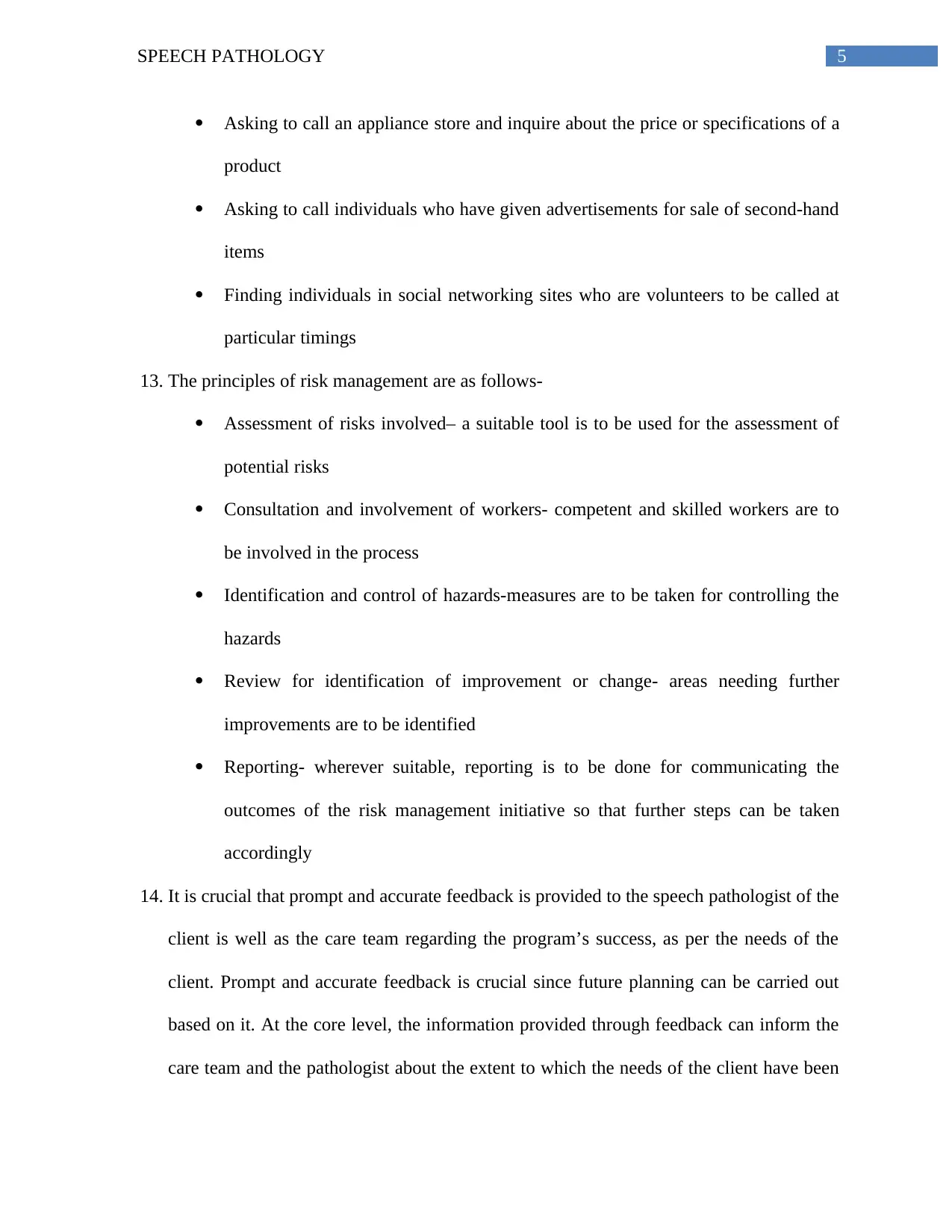
5SPEECH PATHOLOGY
Asking to call an appliance store and inquire about the price or specifications of a
product
Asking to call individuals who have given advertisements for sale of second-hand
items
Finding individuals in social networking sites who are volunteers to be called at
particular timings
13. The principles of risk management are as follows-
Assessment of risks involved– a suitable tool is to be used for the assessment of
potential risks
Consultation and involvement of workers- competent and skilled workers are to
be involved in the process
Identification and control of hazards-measures are to be taken for controlling the
hazards
Review for identification of improvement or change- areas needing further
improvements are to be identified
Reporting- wherever suitable, reporting is to be done for communicating the
outcomes of the risk management initiative so that further steps can be taken
accordingly
14. It is crucial that prompt and accurate feedback is provided to the speech pathologist of the
client is well as the care team regarding the program’s success, as per the needs of the
client. Prompt and accurate feedback is crucial since future planning can be carried out
based on it. At the core level, the information provided through feedback can inform the
care team and the pathologist about the extent to which the needs of the client have been
Asking to call an appliance store and inquire about the price or specifications of a
product
Asking to call individuals who have given advertisements for sale of second-hand
items
Finding individuals in social networking sites who are volunteers to be called at
particular timings
13. The principles of risk management are as follows-
Assessment of risks involved– a suitable tool is to be used for the assessment of
potential risks
Consultation and involvement of workers- competent and skilled workers are to
be involved in the process
Identification and control of hazards-measures are to be taken for controlling the
hazards
Review for identification of improvement or change- areas needing further
improvements are to be identified
Reporting- wherever suitable, reporting is to be done for communicating the
outcomes of the risk management initiative so that further steps can be taken
accordingly
14. It is crucial that prompt and accurate feedback is provided to the speech pathologist of the
client is well as the care team regarding the program’s success, as per the needs of the
client. Prompt and accurate feedback is crucial since future planning can be carried out
based on it. At the core level, the information provided through feedback can inform the
care team and the pathologist about the extent to which the needs of the client have been
⊘ This is a preview!⊘
Do you want full access?
Subscribe today to unlock all pages.

Trusted by 1+ million students worldwide
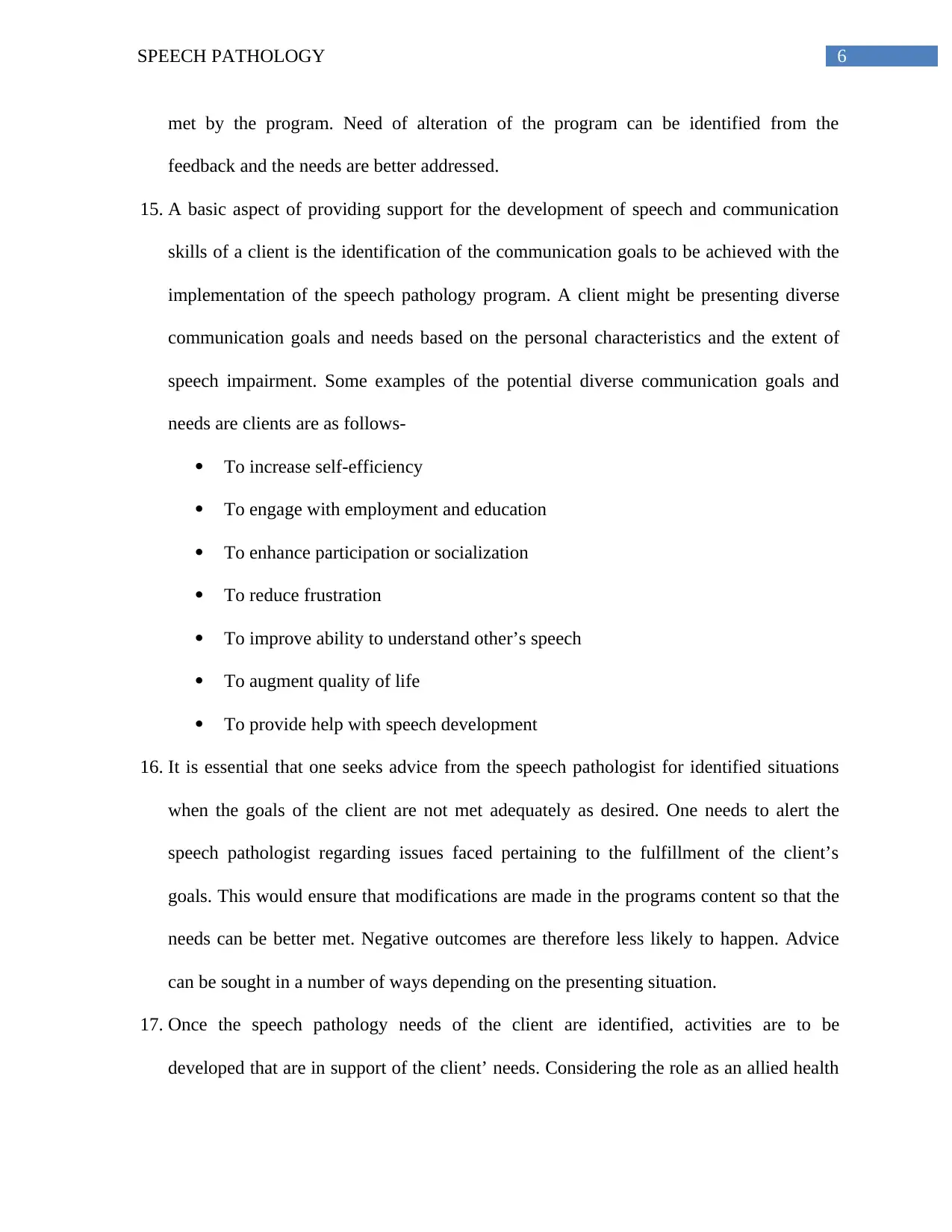
6SPEECH PATHOLOGY
met by the program. Need of alteration of the program can be identified from the
feedback and the needs are better addressed.
15. A basic aspect of providing support for the development of speech and communication
skills of a client is the identification of the communication goals to be achieved with the
implementation of the speech pathology program. A client might be presenting diverse
communication goals and needs based on the personal characteristics and the extent of
speech impairment. Some examples of the potential diverse communication goals and
needs are clients are as follows-
To increase self-efficiency
To engage with employment and education
To enhance participation or socialization
To reduce frustration
To improve ability to understand other’s speech
To augment quality of life
To provide help with speech development
16. It is essential that one seeks advice from the speech pathologist for identified situations
when the goals of the client are not met adequately as desired. One needs to alert the
speech pathologist regarding issues faced pertaining to the fulfillment of the client’s
goals. This would ensure that modifications are made in the programs content so that the
needs can be better met. Negative outcomes are therefore less likely to happen. Advice
can be sought in a number of ways depending on the presenting situation.
17. Once the speech pathology needs of the client are identified, activities are to be
developed that are in support of the client’ needs. Considering the role as an allied health
met by the program. Need of alteration of the program can be identified from the
feedback and the needs are better addressed.
15. A basic aspect of providing support for the development of speech and communication
skills of a client is the identification of the communication goals to be achieved with the
implementation of the speech pathology program. A client might be presenting diverse
communication goals and needs based on the personal characteristics and the extent of
speech impairment. Some examples of the potential diverse communication goals and
needs are clients are as follows-
To increase self-efficiency
To engage with employment and education
To enhance participation or socialization
To reduce frustration
To improve ability to understand other’s speech
To augment quality of life
To provide help with speech development
16. It is essential that one seeks advice from the speech pathologist for identified situations
when the goals of the client are not met adequately as desired. One needs to alert the
speech pathologist regarding issues faced pertaining to the fulfillment of the client’s
goals. This would ensure that modifications are made in the programs content so that the
needs can be better met. Negative outcomes are therefore less likely to happen. Advice
can be sought in a number of ways depending on the presenting situation.
17. Once the speech pathology needs of the client are identified, activities are to be
developed that are in support of the client’ needs. Considering the role as an allied health
Paraphrase This Document
Need a fresh take? Get an instant paraphrase of this document with our AI Paraphraser
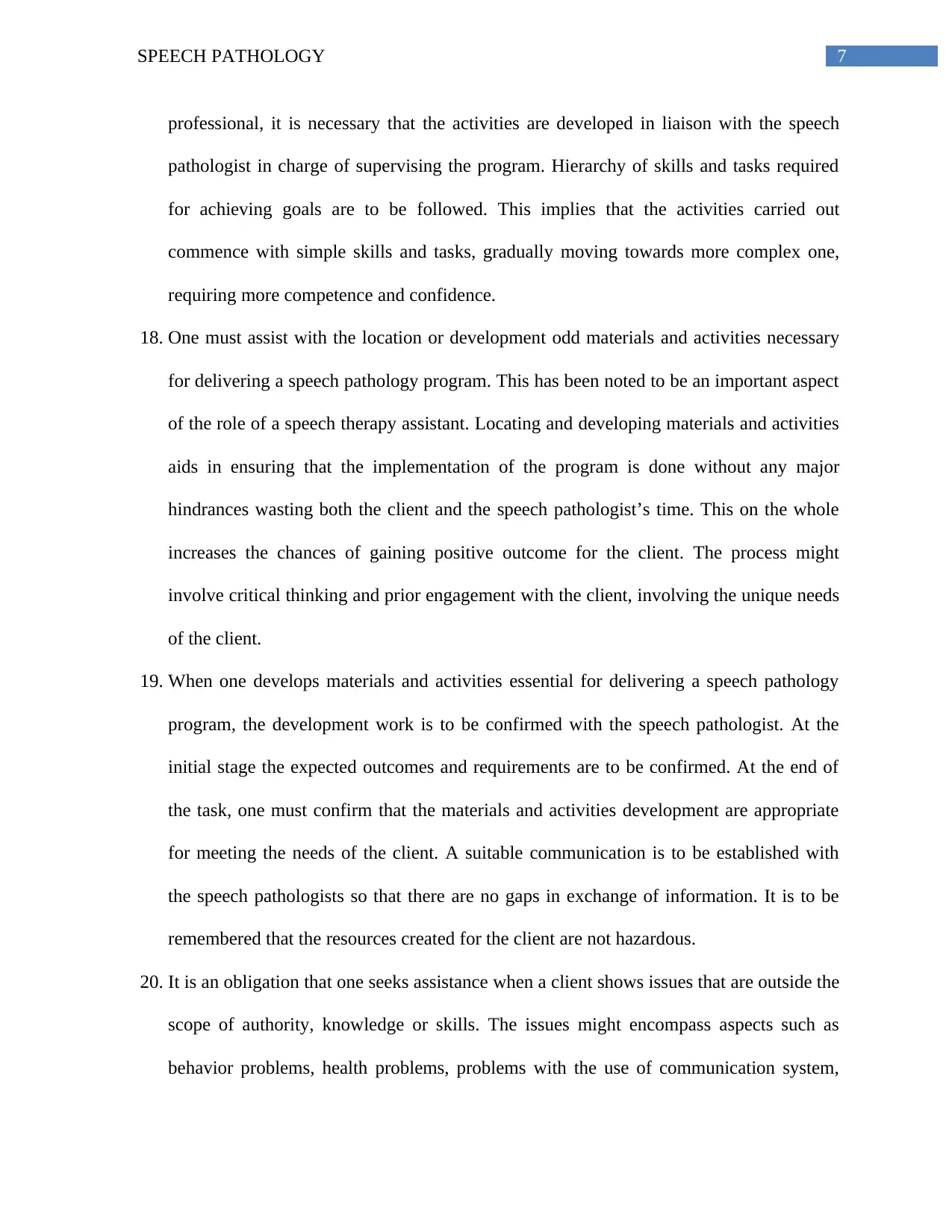
7SPEECH PATHOLOGY
professional, it is necessary that the activities are developed in liaison with the speech
pathologist in charge of supervising the program. Hierarchy of skills and tasks required
for achieving goals are to be followed. This implies that the activities carried out
commence with simple skills and tasks, gradually moving towards more complex one,
requiring more competence and confidence.
18. One must assist with the location or development odd materials and activities necessary
for delivering a speech pathology program. This has been noted to be an important aspect
of the role of a speech therapy assistant. Locating and developing materials and activities
aids in ensuring that the implementation of the program is done without any major
hindrances wasting both the client and the speech pathologist’s time. This on the whole
increases the chances of gaining positive outcome for the client. The process might
involve critical thinking and prior engagement with the client, involving the unique needs
of the client.
19. When one develops materials and activities essential for delivering a speech pathology
program, the development work is to be confirmed with the speech pathologist. At the
initial stage the expected outcomes and requirements are to be confirmed. At the end of
the task, one must confirm that the materials and activities development are appropriate
for meeting the needs of the client. A suitable communication is to be established with
the speech pathologists so that there are no gaps in exchange of information. It is to be
remembered that the resources created for the client are not hazardous.
20. It is an obligation that one seeks assistance when a client shows issues that are outside the
scope of authority, knowledge or skills. The issues might encompass aspects such as
behavior problems, health problems, problems with the use of communication system,
professional, it is necessary that the activities are developed in liaison with the speech
pathologist in charge of supervising the program. Hierarchy of skills and tasks required
for achieving goals are to be followed. This implies that the activities carried out
commence with simple skills and tasks, gradually moving towards more complex one,
requiring more competence and confidence.
18. One must assist with the location or development odd materials and activities necessary
for delivering a speech pathology program. This has been noted to be an important aspect
of the role of a speech therapy assistant. Locating and developing materials and activities
aids in ensuring that the implementation of the program is done without any major
hindrances wasting both the client and the speech pathologist’s time. This on the whole
increases the chances of gaining positive outcome for the client. The process might
involve critical thinking and prior engagement with the client, involving the unique needs
of the client.
19. When one develops materials and activities essential for delivering a speech pathology
program, the development work is to be confirmed with the speech pathologist. At the
initial stage the expected outcomes and requirements are to be confirmed. At the end of
the task, one must confirm that the materials and activities development are appropriate
for meeting the needs of the client. A suitable communication is to be established with
the speech pathologists so that there are no gaps in exchange of information. It is to be
remembered that the resources created for the client are not hazardous.
20. It is an obligation that one seeks assistance when a client shows issues that are outside the
scope of authority, knowledge or skills. The issues might encompass aspects such as
behavior problems, health problems, problems with the use of communication system,

8SPEECH PATHOLOGY
and effective positioning of the client. Further, issues might arise pertaining to a change
in the client’s ability to engage in communication. All of these issues are critical in nature
and require urgent attention. There lie different methods in which one can seek assistance
at the time of need, and each has its own applicability.
21. I can report about client’s difficulties to the supervising allied health professional by
liaising with the client’s health professionals such as the speech pathologist regarding the
issues. I can direct contact the speech pathologist to report about situations where the
client’s goal cannot be met and take advice from them regarding the possible
modifications in the process to meet the client’s need. I can do this either by face-to-face
contact or by direct interaction with speech pathologist. If informal methods of
consultations do not exit, then I would follow formal mechanisms such as written reports
and documentation to report about specific challenges in working with the client.
22. The main purpose of clinical supervision is to ensure that the high quality patient care is
provided and deliver treatment through accountable practice. Clinical supervision is also
important for staffs working in speech pathology services to promote learning and
professional development of staffs and maintain well-being and motivation of staff by
means of constant supervision. Clinical supervision is an important strategy to enhance
the quality and safety of care and promote achievement of desired competence in clinical
practice. The provision of clinical supervision in an organization can lead to reflective
practice and identification of procedures to acquire new skills in practice.
23. While taking part in the supervision process, my responsibility will be to actively take
part in the supervision process so I that I can express all my needs and expectations
openly to the supervisor. This will also help in moving forward towards lifelong learning.
and effective positioning of the client. Further, issues might arise pertaining to a change
in the client’s ability to engage in communication. All of these issues are critical in nature
and require urgent attention. There lie different methods in which one can seek assistance
at the time of need, and each has its own applicability.
21. I can report about client’s difficulties to the supervising allied health professional by
liaising with the client’s health professionals such as the speech pathologist regarding the
issues. I can direct contact the speech pathologist to report about situations where the
client’s goal cannot be met and take advice from them regarding the possible
modifications in the process to meet the client’s need. I can do this either by face-to-face
contact or by direct interaction with speech pathologist. If informal methods of
consultations do not exit, then I would follow formal mechanisms such as written reports
and documentation to report about specific challenges in working with the client.
22. The main purpose of clinical supervision is to ensure that the high quality patient care is
provided and deliver treatment through accountable practice. Clinical supervision is also
important for staffs working in speech pathology services to promote learning and
professional development of staffs and maintain well-being and motivation of staff by
means of constant supervision. Clinical supervision is an important strategy to enhance
the quality and safety of care and promote achievement of desired competence in clinical
practice. The provision of clinical supervision in an organization can lead to reflective
practice and identification of procedures to acquire new skills in practice.
23. While taking part in the supervision process, my responsibility will be to actively take
part in the supervision process so I that I can express all my needs and expectations
openly to the supervisor. This will also help in moving forward towards lifelong learning.
⊘ This is a preview!⊘
Do you want full access?
Subscribe today to unlock all pages.

Trusted by 1+ million students worldwide

9SPEECH PATHOLOGY
I will come prepared with all my queries related to challenges and also try to explain my
problem in a concise manner to save time of the supervisor. I will also ensure to develop
a positive relationship with my supervisor to ensure that the session is meaningful and I
meet honest feedback regarding the changes needed in my professional skills or
approach.
24. While communicating with client’s in a speech pathology setting, different types of
materials and resources are used to aid the communication process. Regular cleaning of
these resources will be essential to ensure that all equipments are in good working order
and prevent spread of infections from one health care professional to other. Cleaning
equipments is also necessary to comply with management protocols and ensure that any
risk to patient health is controlled. Cleaning and decontamination of each resource can
decrease the likelihood of occupation health hazards both for staffs as well as the client.
25. Apart from cleaning, following organization’s procedure to store materials and
equipments are important. The criteria for storing equipment are that it must be stored
according to the manufacturer’s requirement. The storage of equipments and resource is
also dependent on nature and piece of equipment. For example, electronic equipments
should be stored in dry place whereas power cords should not be coiled to prevent
damage. There are also items such as communication boards that need to be regularly
used while communicating with clients. Those items should be stored in easily accessible
places. Deciding appropriate location for storing device is also important as some should
be stored in organization’s premise or in client’s residence.
I will come prepared with all my queries related to challenges and also try to explain my
problem in a concise manner to save time of the supervisor. I will also ensure to develop
a positive relationship with my supervisor to ensure that the session is meaningful and I
meet honest feedback regarding the changes needed in my professional skills or
approach.
24. While communicating with client’s in a speech pathology setting, different types of
materials and resources are used to aid the communication process. Regular cleaning of
these resources will be essential to ensure that all equipments are in good working order
and prevent spread of infections from one health care professional to other. Cleaning
equipments is also necessary to comply with management protocols and ensure that any
risk to patient health is controlled. Cleaning and decontamination of each resource can
decrease the likelihood of occupation health hazards both for staffs as well as the client.
25. Apart from cleaning, following organization’s procedure to store materials and
equipments are important. The criteria for storing equipment are that it must be stored
according to the manufacturer’s requirement. The storage of equipments and resource is
also dependent on nature and piece of equipment. For example, electronic equipments
should be stored in dry place whereas power cords should not be coiled to prevent
damage. There are also items such as communication boards that need to be regularly
used while communicating with clients. Those items should be stored in easily accessible
places. Deciding appropriate location for storing device is also important as some should
be stored in organization’s premise or in client’s residence.
Paraphrase This Document
Need a fresh take? Get an instant paraphrase of this document with our AI Paraphraser
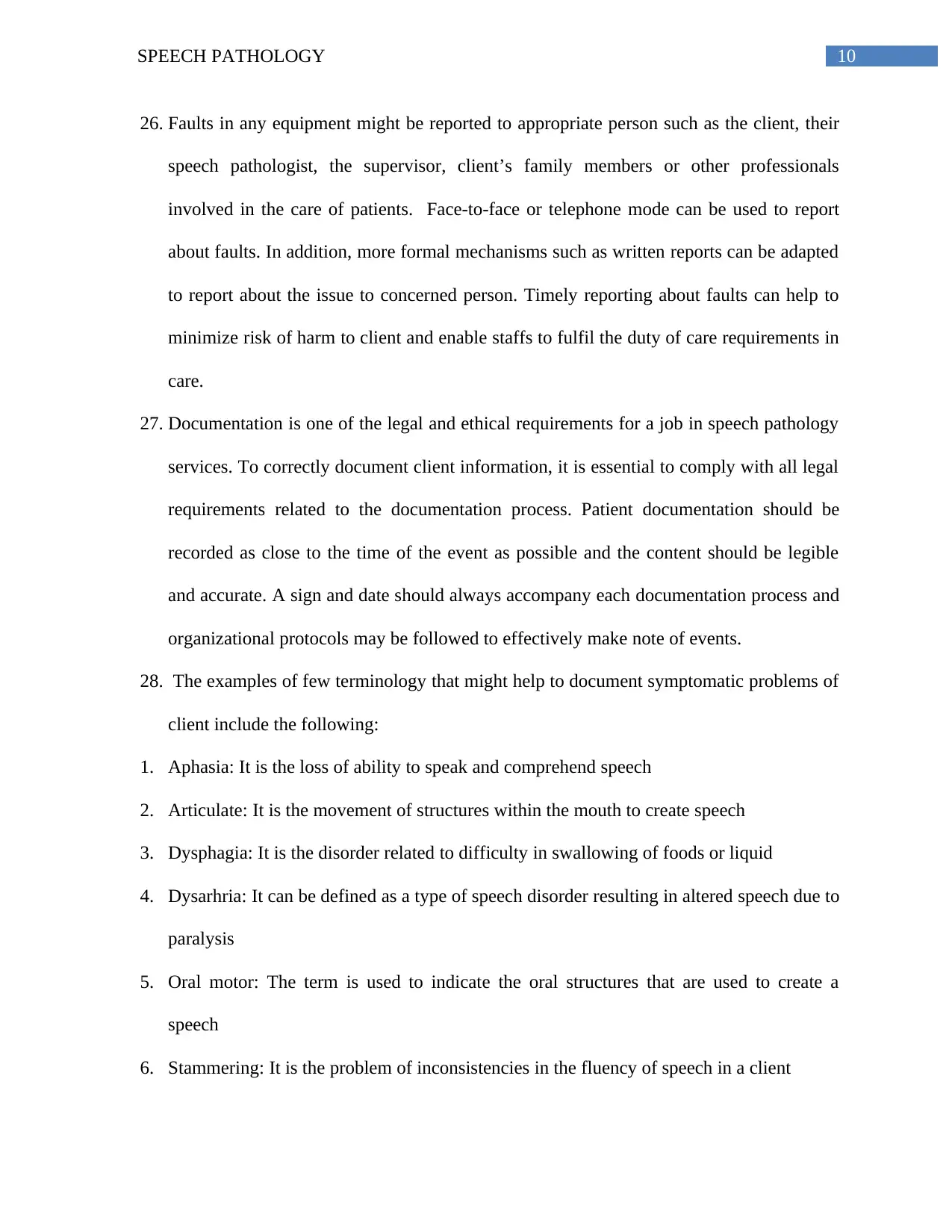
10SPEECH PATHOLOGY
26. Faults in any equipment might be reported to appropriate person such as the client, their
speech pathologist, the supervisor, client’s family members or other professionals
involved in the care of patients. Face-to-face or telephone mode can be used to report
about faults. In addition, more formal mechanisms such as written reports can be adapted
to report about the issue to concerned person. Timely reporting about faults can help to
minimize risk of harm to client and enable staffs to fulfil the duty of care requirements in
care.
27. Documentation is one of the legal and ethical requirements for a job in speech pathology
services. To correctly document client information, it is essential to comply with all legal
requirements related to the documentation process. Patient documentation should be
recorded as close to the time of the event as possible and the content should be legible
and accurate. A sign and date should always accompany each documentation process and
organizational protocols may be followed to effectively make note of events.
28. The examples of few terminology that might help to document symptomatic problems of
client include the following:
1. Aphasia: It is the loss of ability to speak and comprehend speech
2. Articulate: It is the movement of structures within the mouth to create speech
3. Dysphagia: It is the disorder related to difficulty in swallowing of foods or liquid
4. Dysarhria: It can be defined as a type of speech disorder resulting in altered speech due to
paralysis
5. Oral motor: The term is used to indicate the oral structures that are used to create a
speech
6. Stammering: It is the problem of inconsistencies in the fluency of speech in a client
26. Faults in any equipment might be reported to appropriate person such as the client, their
speech pathologist, the supervisor, client’s family members or other professionals
involved in the care of patients. Face-to-face or telephone mode can be used to report
about faults. In addition, more formal mechanisms such as written reports can be adapted
to report about the issue to concerned person. Timely reporting about faults can help to
minimize risk of harm to client and enable staffs to fulfil the duty of care requirements in
care.
27. Documentation is one of the legal and ethical requirements for a job in speech pathology
services. To correctly document client information, it is essential to comply with all legal
requirements related to the documentation process. Patient documentation should be
recorded as close to the time of the event as possible and the content should be legible
and accurate. A sign and date should always accompany each documentation process and
organizational protocols may be followed to effectively make note of events.
28. The examples of few terminology that might help to document symptomatic problems of
client include the following:
1. Aphasia: It is the loss of ability to speak and comprehend speech
2. Articulate: It is the movement of structures within the mouth to create speech
3. Dysphagia: It is the disorder related to difficulty in swallowing of foods or liquid
4. Dysarhria: It can be defined as a type of speech disorder resulting in altered speech due to
paralysis
5. Oral motor: The term is used to indicate the oral structures that are used to create a
speech
6. Stammering: It is the problem of inconsistencies in the fluency of speech in a client

11SPEECH PATHOLOGY
7. Aspiration: It is the term used to denote passage of air or other material through the vocal
folds.
8. Epiglottis: It is the structure in the pharynx that provides support during the swallowing
process
9. Intelligible: The ability of the client to make speech in way that is comprehensible for all
10. Hypernasality: The tendency to speak with nose.
7. Aspiration: It is the term used to denote passage of air or other material through the vocal
folds.
8. Epiglottis: It is the structure in the pharynx that provides support during the swallowing
process
9. Intelligible: The ability of the client to make speech in way that is comprehensible for all
10. Hypernasality: The tendency to speak with nose.
⊘ This is a preview!⊘
Do you want full access?
Subscribe today to unlock all pages.

Trusted by 1+ million students worldwide
1 out of 13
Related Documents
Your All-in-One AI-Powered Toolkit for Academic Success.
+13062052269
info@desklib.com
Available 24*7 on WhatsApp / Email
![[object Object]](/_next/static/media/star-bottom.7253800d.svg)
Unlock your academic potential
Copyright © 2020–2025 A2Z Services. All Rights Reserved. Developed and managed by ZUCOL.





